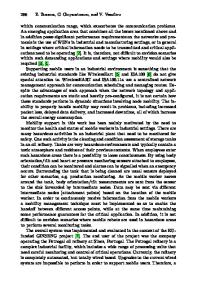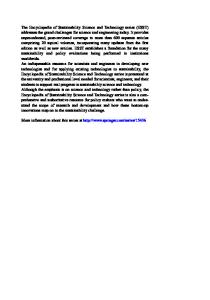Time-Sensitive Networking for Industrial Control Networks
Industrial communication networks, till date, have often relied on proprietary solutions for handling real-time control applications. These solutions are usually not interoperable with each other and are furthermore highly engineered to transport time-sen
- PDF / 7,103,676 Bytes
- 304 Pages / 439.43 x 683.15 pts Page_size
- 19 Downloads / 348 Views
less Networks and Industrial IoT Applications, Challenges and Enablers
Wireless Networks and Industrial IoT
Nurul Huda Mahmood • Nikolaj Marchenko Mikael Gidlund • Petar Popovski Editors
Wireless Networks and Industrial IoT Applications, Challenges and Enablers
Editors Nurul Huda Mahmood 6G Flagship, Center for Wireless Communications (CWC) University of Oulu Oulu, Finland Mikael Gidlund Department of Information Systems and Tech. Mid Sweden University V¨asternorrlands L¨an Sundsvall, Sweden
Nikolaj Marchenko Corporate Research and Advanced Engineering Robert Bosch GmbH (Germany) Stuttgart, Germany Petar Popovski Connectivity Section, Department of Electronic Systems Aalborg University Aalborg Øst, Denmark
ISBN 978-3-030-51472-3 ISBN 978-3-030-51473-0 (eBook) https://doi.org/10.1007/978-3-030-51473-0 © Springer Nature Switzerland AG 2021 This work is subject to copyright. All rights are reserved by the Publisher, whether the whole or part of the material is concerned, specifically the rights of translation, reprinting, reuse of illustrations, recitation, broadcasting, reproduction on microfilms or in any other physical way, and transmission or information storage and retrieval, electronic adaptation, computer software, or by similar or dissimilar methodology now known or hereafter developed. The use of general descriptive names, registered names, trademarks, service marks, etc. in this publication does not imply, even in the absence of a specific statement, that such names are exempt from the relevant protective laws and regulations and therefore free for general use. The publisher, the authors, and the editors are safe to assume that the advice and information in this book are believed to be true and accurate at the date of publication. Neither the publisher nor the authors or the editors give a warranty, expressed or implied, with respect to the material contained herein or for any errors or omissions that may have been made. The publisher remains neutral with regard to jurisdictional claims in published maps and institutional affiliations. This Springer imprint is published by the registered company Springer Nature Switzerland AG. The registered company address is: Gewerbestrasse 11, 6330 Cham, Switzerland
Preface
The recent decade has been marked by an unprecedented development of wireless networks, smartphones, and cloud computing technologies. Today, more than five billion people are connected with each other and use a vast number of Internet services. In addition to that, the volume of Internet-of-Things (IoT) devices started to proliferate during recent years, resulting in a vast variety of “things” connected wirelessly to the Internet, such as home appliances, lights, cars, shipping containers, environmental sensors, etc. The availability of wireless connectivity brings a new quality to these physical objects, allowing them to contribute to digital optimization of various processes and systems. IoT represents now an exponentially growing technology sector, with the number of connected devices exp
Data Loading...











